Effects of Wheat Oligopeptide on the Baking and Retrogradation Properties of Bread Rolls: Evaluation of Crumb Hardness, Moisture Content, and Starch Crystallization
Abstract
:1. Introduction
2. Materials and Methods
2.1. Materials
2.2. Breadmaking Process
2.3. Evaluation of the Qualities of Bread Rolls: Specific Volume, Slice Structure, and Hardness
2.3.1. Specific Volume
2.3.2. Slice Structure Tests (C-Cell)
2.3.3. Hardness Analysis and Staling Kinetics
2.4. Moisture Content Determination
2.5. Retrogradation Properties Analysis
2.5.1. Differential Scanning Calorimetry Analysis
2.5.2. Long-Range Ordered Structure Analysis Using XRD Method
2.5.3. Short-Range Ordered Structure Analysis Using FTIR
2.5.4. Scanning Electron Microscopy (SEM) Analysis
2.6. Statistical Analysis
3. Results
3.1. Effects of WOP on the Qualities of Bread Rolls
3.1.1. Specific Volume of Bread Rolls
3.1.2. Image C-Cell Analysis of Bread Roll Crumbs
3.1.3. Effects of WOP on the Hardness of Bread Roll Crumbs during the Storage Process
3.1.4. Kinetics of the Retrogradation Process
3.2. Thermal Properties of Starch
3.3. Long-Range Ordered Structure Analysis Using XRD Method
3.4. Short-Range Ordered Structure Analysis Using FTIR
3.5. Moisture Content Determination
3.6. SEM
4. Conclusions
Author Contributions
Funding
Institutional Review Board Statement
Informed Consent Statement
Data Availability Statement
Conflicts of Interest
References
- Rahman, M.; Islam, R.; Hasan, S.; Zzaman, W.; Rana, M.R.; Ahmed, S.; Roy, M.; Sayem, A.; Matin, A.; Raposo, A.; et al. A Comprehensive review on bio-preservation of bread: An approach to adopt wholesome strategies. Foods 2022, 11, 319. [Google Scholar] [CrossRef]
- Taglieri, I.; Macaluso, M.; Bianchi, A.; Sanmartin, C.; Quartacci, M.F.; Zinnai, A.; Venturi, F. Overcoming bread quality decay concerns: Main issues for bread shelf life as a function of biological leavening agents and different extra ingredients used in formulation. a review. J. Sci. Food Agric. 2021, 101, 1732–1743. [Google Scholar] [CrossRef]
- Fadda, C.; Sanguinetti, A.M.; Del Caro, A.; Collar, C.; Piga, A. Bread staling: Updating the view. Comp. Rev. Food Sci. Food Saf. 2014, 13, 473–492. [Google Scholar] [CrossRef]
- Ma, M.; Mu, T.; Sun, H.; Zhou, L. Evaluation of texture, retrogradation enthalpy, water mobility, and anti-staling effects of enzymes and hydrocolloids in potato steamed bread. Food Chem. 2022, 368, 130686. [Google Scholar] [CrossRef]
- Liu, Y.; Zhang, X.; Ding, B.; Ding, W.; Xiao, S.; Song, J.; Lyu, Q.; Ke, Y.; Wang, X.; Fu, Y. Effect of hydrocolloids on physical, thermal and microstructure properties of par-baked baguette during frozen storage. Int. J. Biol. Macromol. 2020, 163, 1866–1874. [Google Scholar] [CrossRef] [PubMed]
- Xie, Q.; Liu, X.; Xiao, S.; Pan, W.; Wu, Y.; Ding, W.; Lyu, Q.; Wang, X.; Fu, Y. Effect of mulberry leaf polysaccharides on the baking and staling properties of frozen dough bread. J. Sci. Food Agric. 2022, 102, 6071–6079. [Google Scholar] [CrossRef] [PubMed]
- Kang, N.; Reddy, C.K.; Park, E.Y.; Choi, H.-D.; Lim, S.-T. Antistaling effects of hydrocolloids and modified starch on bread during cold storage. LWT Food Sci. Technol. 2018, 96, 13–18. [Google Scholar] [CrossRef]
- Tebben, L.; Shen, Y.; Li, Y. Improvers and functional ingredients in whole wheat bread: A review of their effects on dough properties and bread quality. Trends Food Sci. Technol. 2018, 81, 10–24. [Google Scholar] [CrossRef]
- Xiao, J.; Zhong, Q. Suppression of retrogradation of gelatinized rice starch by anti-listerial grass carp protein hydrolysate. Food Hydrocoll. 2017, 72, 338–345. [Google Scholar] [CrossRef]
- Paraskevopoulou, A.; Provatidou, E.; Tsotsiou, D.; Kiosseoglou, V. Dough rheology and baking performance of wheat flour–lupin protein isolate blends. Food Res. Int. 2010, 43, 1009–1016. [Google Scholar] [CrossRef]
- Xie, X.; Wu, X.; Shen, Y.; Song, M.; Xu, C.; Zhang, B.; Aziz, U.; Xu, X. Effect of poly-γ-glutamic acid on hydration and structure of wheat gluten. J. Food Sci. 2020, 85, 3214–3219. [Google Scholar] [CrossRef]
- Liu, H.; Wan, L.; Xiao, S.; Fu, Y.; Wang, X. Changes in the physicochemical and protein distribution properties of dough with the wheat oligopeptide incorporation. Food Biosci. 2023, 52, 102354. [Google Scholar] [CrossRef]
- Xian, Y.; Da, P.; Chao, Y.; Hui, X.; Ligang, Y.; Shaokang, W.; Guiju, S. Wheat oligopeptides enhance the intestinal mucosal barrier and alleviate inflammation via the TLR4/Myd88/MAPK signaling pathway in aged mice. Food Nutr. Res. 2022, 66, 5690. [Google Scholar] [CrossRef]
- Montserrat-de La Paz, S.; Rodriguez-Martin, N.M.; Villanueva, A.; Pedroche, J.; Cruz-Chamorro, I.; Millan, F.; Millan-Linares, M.C. Evaluation of anti-inflammatory and atheroprotective properties of wheat gluten protein hydrolysates in primary human monocytes. Foods 2020, 9, 854. [Google Scholar] [CrossRef] [PubMed]
- Wan, L.; Wang, X.; Liu, H.; Xiao, S.; Ding, W.; Pan, X.; Fu, Y. Retrogradation inhibition of wheat starch with wheat oligopeptides. Food Chem. 2023, 427, 136723. [Google Scholar] [CrossRef] [PubMed]
- Zhang, S.; Jia, X.; Xu, L.; Xue, Y.; Pan, Q.; Shen, W.; Wang, Z. Effect of extrusion and semi-solid enzymatic hydrolysis modifications on the quality of wheat bran and steamed bread containing bran. J. Cereal Sci. 2022, 108, 103577. [Google Scholar] [CrossRef]
- Xu, X.; Luo, Z.; Yang, Q.; Xiao, Z.; Lu, X. Effect of quinoa flour on baking performance, antioxidant properties and digestibility of wheat bread. Food Chem. 2019, 294, 87–95. [Google Scholar] [CrossRef]
- Xin, C.; Nie, L.; Chen, H.; Li, J.; Li, B. Effect of degree of substitution of carboxymethyl cellulose sodium on the state of water, rheological and baking performance of frozen bread dough. Food Hydrocoll. 2018, 80, 8–14. [Google Scholar] [CrossRef]
- Ding, S.; Peng, B.; Li, Y.; Yang, J. Evaluation of specific volume, texture, thermal features, water mobility, and inhibitory effect of staling in wheat bread affected by maltitol. Food Chem. 2019, 283, 123–130. [Google Scholar] [CrossRef]
- Skendi, A.; Mouselemidou, P.; Papageorgiou, M.; Papastergiadis, E. Effect of acorn meal-water combinations on technological properties and fine structure of gluten-free bread. Food Chem. 2018, 253, 119–126. [Google Scholar] [CrossRef]
- Xu, Z.; Ma, Y.; Hong, T.; Shao, G.; Lv, L.; Xu, D.; Wu, F.; Xu, X. Effect of liquid fermented chinese edible ganoderma lucidum fungus on wheat bread: A quality improver and staling inhibitor. Food Control 2024, 155, 110060. [Google Scholar] [CrossRef]
- Wu, F.; Lv, P.; Yang, N.; Jin, Y.; Jin, Z.; Xu, X. Preparation of maillard reaction flavor additive from germinated wheat and its effect on bread quality. Cereal Chem. 2018, 95, 98–108. [Google Scholar] [CrossRef]
- Dudu, O.E.; Ma, Y.; Adelekan, A.; Oyedeji, A.B.; Oyeyinka, S.A.; Ogungbemi, J.W. Bread-making potential of heat-moisture treated cassava flour-additive complexes. LWT Food Sci. Technol. 2020, 130, 109477. [Google Scholar] [CrossRef]
- Zhou, J.; Liu, J.; Tang, X. Effects of whey and soy protein addition on bread rheological property of wheat flour. J. Texture Stud. 2018, 49, 38–46. [Google Scholar] [CrossRef]
- Méndez, P.X.; Uña, J.A.; Vega-Fernández, S.; Santos, M.Á. The ability of the yeast wickerhamomyces anomalus to hydrolyze immunogenic wheat gliadin proteins. Foods 2022, 11, 4105. [Google Scholar] [CrossRef]
- Zhou, J.; Yang, H.; Qin, X.; Hu, X.; Liu, G.; Wang, X. Effect of β-cyclodextrin on the quality of wheat flour dough and prebaked bread. Food Biophys. 2019, 14, 173–181. [Google Scholar] [CrossRef]
- Wang, N.; Hou, G.G.; Dubat, A. Effects of flour particle size on the quality attributes of reconstituted whole-wheat flour and chinese southern-type steamed bread. LWT Food Sci. Technol. 2017, 82, 147–153. [Google Scholar] [CrossRef]
- Lin, J.; Sun-Waterhouse, D.; Tang, R.; Cui, C.; Wang, W.; Xiong, J. The Effect of γ-[glu](1 ≤ n ≤ 5)-gln on the physicochemical characteristics of frozen dough and the quality of baked bread. Food Chem. 2021, 343, 128406. [Google Scholar] [CrossRef]
- Guarda, A.; Rosell, C.M.; Benedito, C.; Galotto, M.J. Different hydrocolloids as bread improvers and antistaling agents. Food Hydrocoll. 2004, 18, 241–247. [Google Scholar] [CrossRef]
- Ammar, A.; Siddeeg, A.; Aqlan, F.M.; Howladar, S.M.; Refai, M.Y.; Afifi, M.; Ali, H.A.; Hajjar, D.; Sulamain, M.G.M.; Chamba, M.V.M.; et al. Shelf-life extension of wheat bread by alhydwan flour and carboxymethylcellulose and improvement of their quality characteristics, dough rheological and microstructure. Int. J. Biol. Macromol. 2020, 156, 851–857. [Google Scholar] [CrossRef]
- Kong, X.-R.; Zhu, Z.-Y.; Zhang, X.-J.; Zhu, Y.-M. Effects of cordyceps polysaccharides on pasting properties and in vitro starch digestibility of wheat starch. Food Hydrocoll. 2020, 102, 105604. [Google Scholar] [CrossRef]
- Tomić, J.; Torbica, A.; Belović, M. Effect of non-gluten proteins and transglutaminase on dough rheological properties and quality of bread based on millet (Panicum miliaceum) flour. LWT Food Sci. Technol. 2020, 118, 108852. [Google Scholar] [CrossRef]
- Karimi, A.; Ahmadi Gavlighi, H.; Amini Sarteshnizi, R.; Udenigwe, C.C. Effect of maize germ protein hydrolysate addition on digestion, in vitro antioxidant activity and quality characteristics of bread. J. Cereal Sci. 2021, 97, 103148. [Google Scholar] [CrossRef]
- Hu, Y.; He, C.; Zhang, M.; Zhang, L.; Xiong, H.; Zhao, Q. Inhibition from whey protein hydrolysate on the retrogradation of gelatinized rice starch. Food Hydrocoll. 2020, 108, 105840. [Google Scholar] [CrossRef]
- Van Steertegem, B.; Pareyt, B.; Brijs, K.; Delcour, J.A. The role of gluten proteins in production and quality of a yeast leavened sugar and fat rich wheat based food model system. Food Res. Int. 2014, 62, 991–997. [Google Scholar] [CrossRef]
- Zhang, H.; Sun, B.; Zhang, S.; Zhu, Y.; Tian, Y. Inhibition of wheat starch retrogradation by tea derivatives. Carbohydr. Polym. 2015, 134, 413–417. [Google Scholar] [CrossRef] [PubMed]
- Niu, H.; Zhang, M.; Xia, X.; Liu, Q.; Kong, B. Effect of porcine plasma protein hydrolysates on long-term retrogradation of corn starch. Food Chem. 2018, 239, 172–179. [Google Scholar] [CrossRef] [PubMed]
- Amigo, J.M.; Del Olmo Alvarez, A.; Engelsen, M.M.; Lundkvist, H.; Engelsen, S.B. Staling of white wheat bread crumb and effect of maltogenic α-amylases. Part 1: Spatial distribution and kinetic modeling of hardness and resilience. Food Chem. 2016, 208, 318–325. [Google Scholar] [CrossRef] [PubMed]
- Ronda, F.; Quilez, J.; Pando, V.; Roos, Y.H. Fermentation time and fiber effects on recrystallization of starch components and staling of bread from frozen part-baked bread. Int. J. Food Eng. 2014, 131, 116–123. [Google Scholar] [CrossRef]
- Zhang, M.; Sun, C.; Wang, X.; Wang, N.; Zhou, Y. Effect of rice protein hydrolysates on the short-term and long-term retrogradation of wheat starch. Int. J. Biol. Macromol. 2020, 155, 1169–1175. [Google Scholar] [CrossRef]
- Matignon, A.; Tecante, A. Starch Retrogradation: From starch components to cereal products. Food Hydrocoll. 2017, 68, 43–52. [Google Scholar] [CrossRef]
- Xie, Q.; Liu, X.; Liu, H.; Zhang, Y.; Xiao, S.; Ding, W.; Lyu, Q.; Fu, Y.; Wang, X. Insight into the effect of garlic peptides on the physicochemical and anti-staling properties of wheat starch. Int. J. Biol. Macromol. 2023, 229, 363–371. [Google Scholar] [CrossRef]
- Chen, Y.; Wang, Y.-S.; Zhang, X.; Chen, H.-H. Retardant effect of different charge-carrying amino acids on the long-term retrogradation of normal corn starch gel. Int. J. Biol. Macromol. 2021, 189, 1020–1028. [Google Scholar] [CrossRef]
- Shumoy, H.; Raes, K. In vitro starch hydrolysis and estimated glycemic index of tef porridge and injera. Food Chem. 2017, 229, 381–387. [Google Scholar] [CrossRef] [PubMed]
- Wu, Y.; Chen, Z.; Li, X.; Li, M. Effect of tea polyphenols on the retrogradation of rice starch. Food Res. Int. 2009, 42, 221–225. [Google Scholar] [CrossRef]
- Dome, K.; Podgorbunskikh, E.; Bychkov, A.; Lomovsky, O. Changes in the crystallinity degree of starch having different types of crystal structure after mechanical pretreatment. Polymers 2020, 12, 641. [Google Scholar] [CrossRef] [PubMed]
- Fu, Y.; Liu, X.; Xie, Q.; Chen, L.; Chang, C.; Wu, W.; Xiao, S.; Wang, X. Effects of laminaria japonica polysaccharides on the texture, retrogradation, and structure performances in frozen dough bread. LWT Food Sci. Technol. 2021, 151, 112239. [Google Scholar] [CrossRef]
- Cao, H.; Wang, X.; Wang, X.; Guan, X.; Huang, K.; Zhang, Y. Effect of storage conditions on the textural properties and in vitro digestibility of wheat bread containing whole quinoa flour. Food Biosci. 2022, 49, 101921. [Google Scholar] [CrossRef]
- Liu, Q.; Chen, P.; Li, P.; Zhao, J.; Olnood, C.G.; Zhao, S.; Yang, X.; Wang, Q.; Chen, X. Effects of salecan on the gelatinization and retrogradation behaviors of wheat starch. LWT Food Sci. Technol. 2023, 186, 115238. [Google Scholar] [CrossRef]
- Chen, L.; Ren, F.; Zhang, Z.; Tong, Q.; Rashed, M.M.A. Effect of pullulan on the short-term and long-term retrogradation of rice starch. Carbohydr. Polym. 2015, 115, 415–421. [Google Scholar] [CrossRef]
- Peng, B.; Li, Y.; Ding, S.; Yang, J. Characterization of textural, rheological, thermal, microstructural, and water mobility in wheat flour dough and bread affected by trehalose. Food Chem. 2017, 233, 369–377. [Google Scholar] [CrossRef]
- Goodfellow, B.J.; Wilson, R.H. A fourier transform IR study of the gelation of amylose and amylopectin. Biopolymers 1990, 30, 1183–1189. [Google Scholar] [CrossRef]
- Liu, J.; Liu, Q.; Yang, Y.; Zhao, S.; Jin, Z.; Zhu, K.; Xu, L.; Jiao, A. Effects of whey protein on the in vitro digestibility and physicochemical properties of potato starch. Int. J. Biol. Macromol. 2021, 193, 1744–1751. [Google Scholar] [CrossRef]
- An, H.; Ma, Q.; Zhang, F.; Zhai, C.; Sun, J.; Tang, Y.; Wang, W. Insight into microstructure evolution during starch retrogradation by infrared and raman spectroscopy combined with two-dimensional correlation spectroscopy analysis. Food Hydrocoll. 2024, 146, 109174. [Google Scholar] [CrossRef]
- Tu, Y.; Huang, S.; Chi, C.; Lu, P.; Chen, L.; Li, L.; Li, X. Digestibility and structure changes of rice starch following co-fermentation of yeast and lactobacillus strains. Int. J. Biol. Macromol. 2021, 184, 530–537. [Google Scholar] [CrossRef] [PubMed]
- Zhang, H.-Y.; Sun, H.-N.; Ma, M.-M.; Mu, T.-H. Dough rheological properties, texture, and structure of high-moisture starch hydrogels with different potassium-, and calcium-based compounds. Food Hydrocoll. 2023, 137, 108337. [Google Scholar] [CrossRef]
- Wang, H.; Li, Y.; Wang, L.; Wang, L.; Li, Z.; Qiu, J. Multi-scale structure, rheological and digestive properties of starch isolated from highland barley kernels subjected to different thermal treatments. Food Hydrocoll. 2022, 129, 107630. [Google Scholar] [CrossRef]
- Zhao, L.; Jin, X.; Wu, J.; Chen, H. Effects of qingke β-glucan with different molecular weights on pasting, gelation, and digestive properties of rice starch. Food Chem. X 2023, 19, 100803. [Google Scholar] [CrossRef] [PubMed]
- Guo, L.; Xu, D.; Fang, F.; Jin, Z.; Xu, X. Effect of glutathione on wheat dough properties and bread quality. J. Cereal Sci. 2020, 96, 103116. [Google Scholar] [CrossRef]
- Farbo, M.G.; Fadda, C.; Marceddu, S.; Conte, P.; Del Caro, A.; Piga, A. Improving the quality of dough obtained with old durum wheat using hydrocolloids. Food Hydrocoll. 2020, 101, 105467. [Google Scholar] [CrossRef]
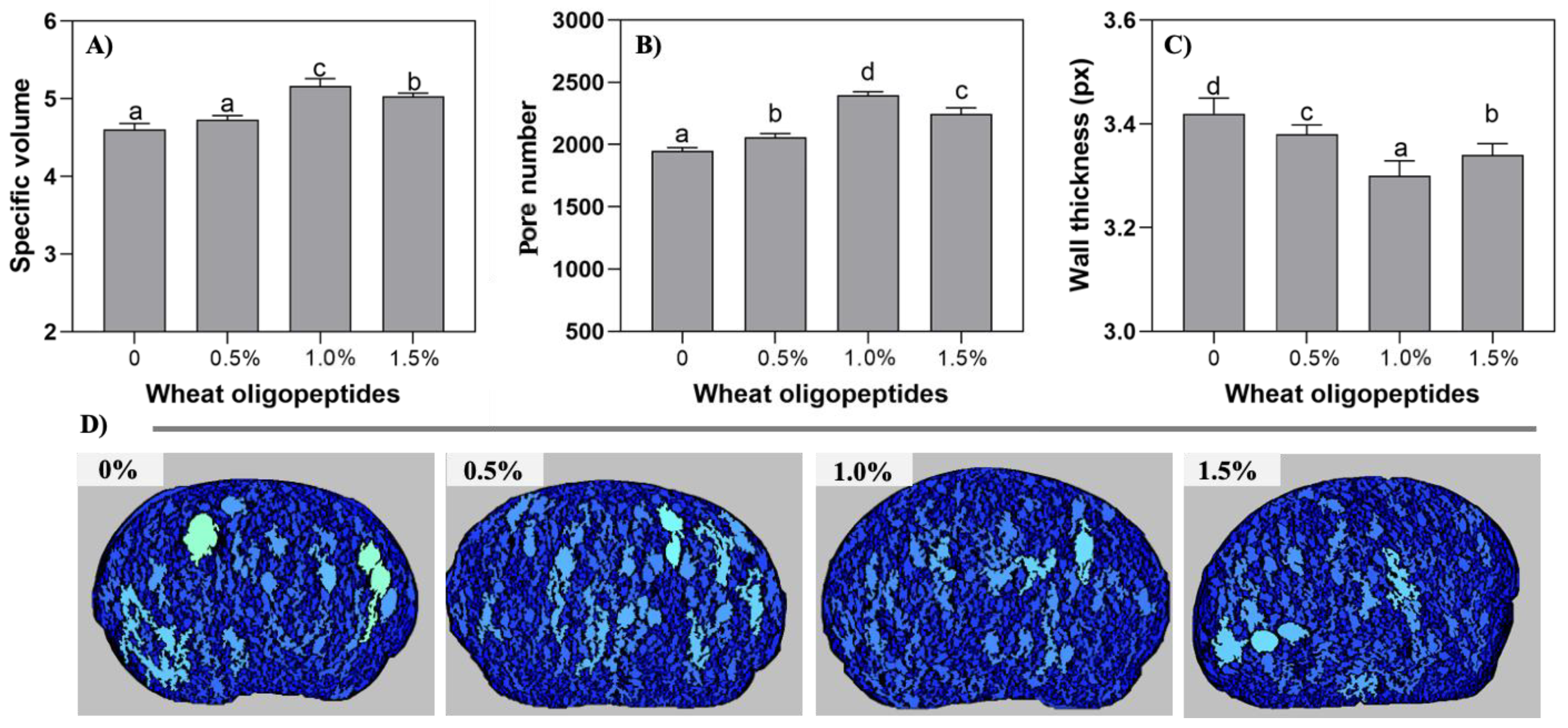
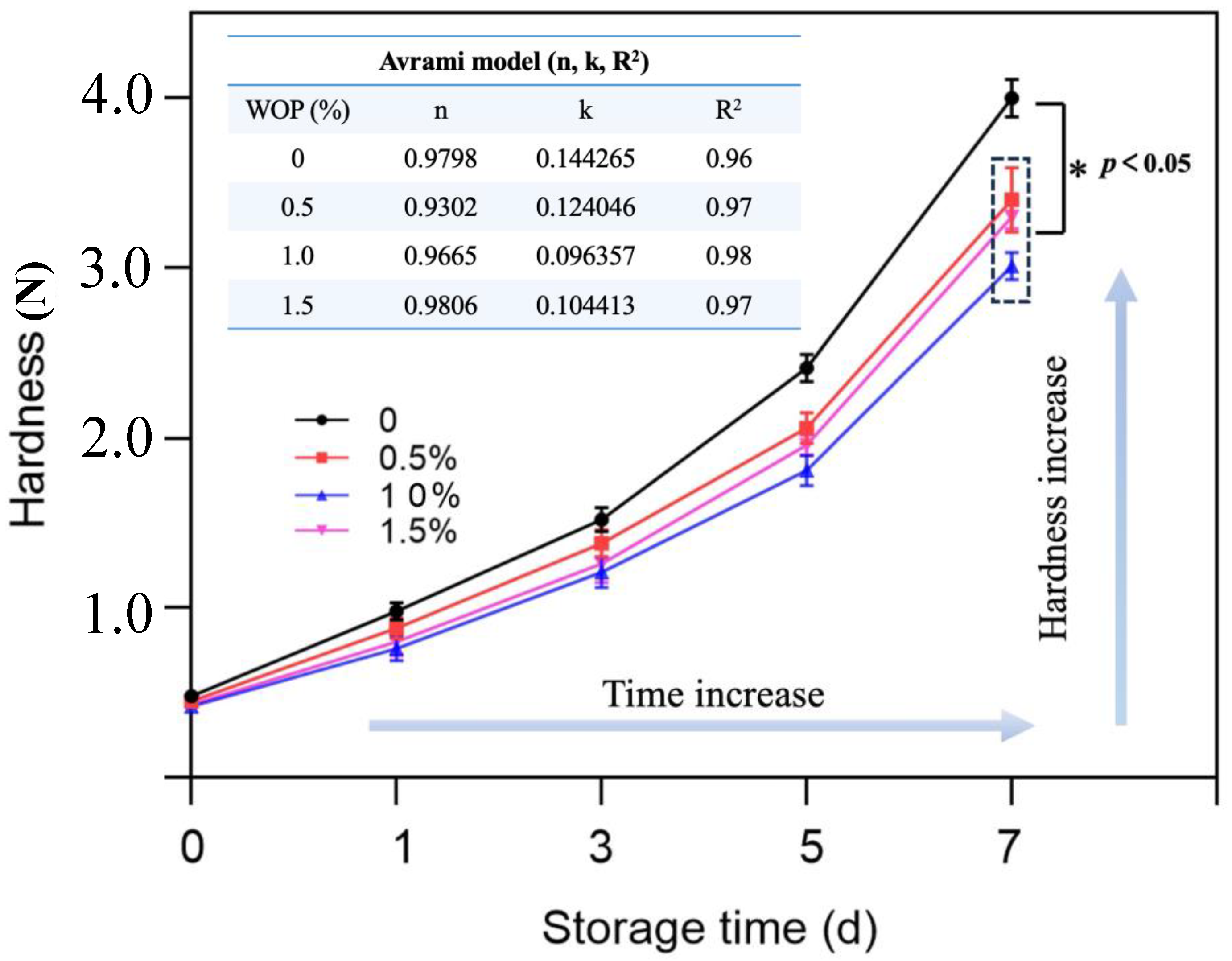
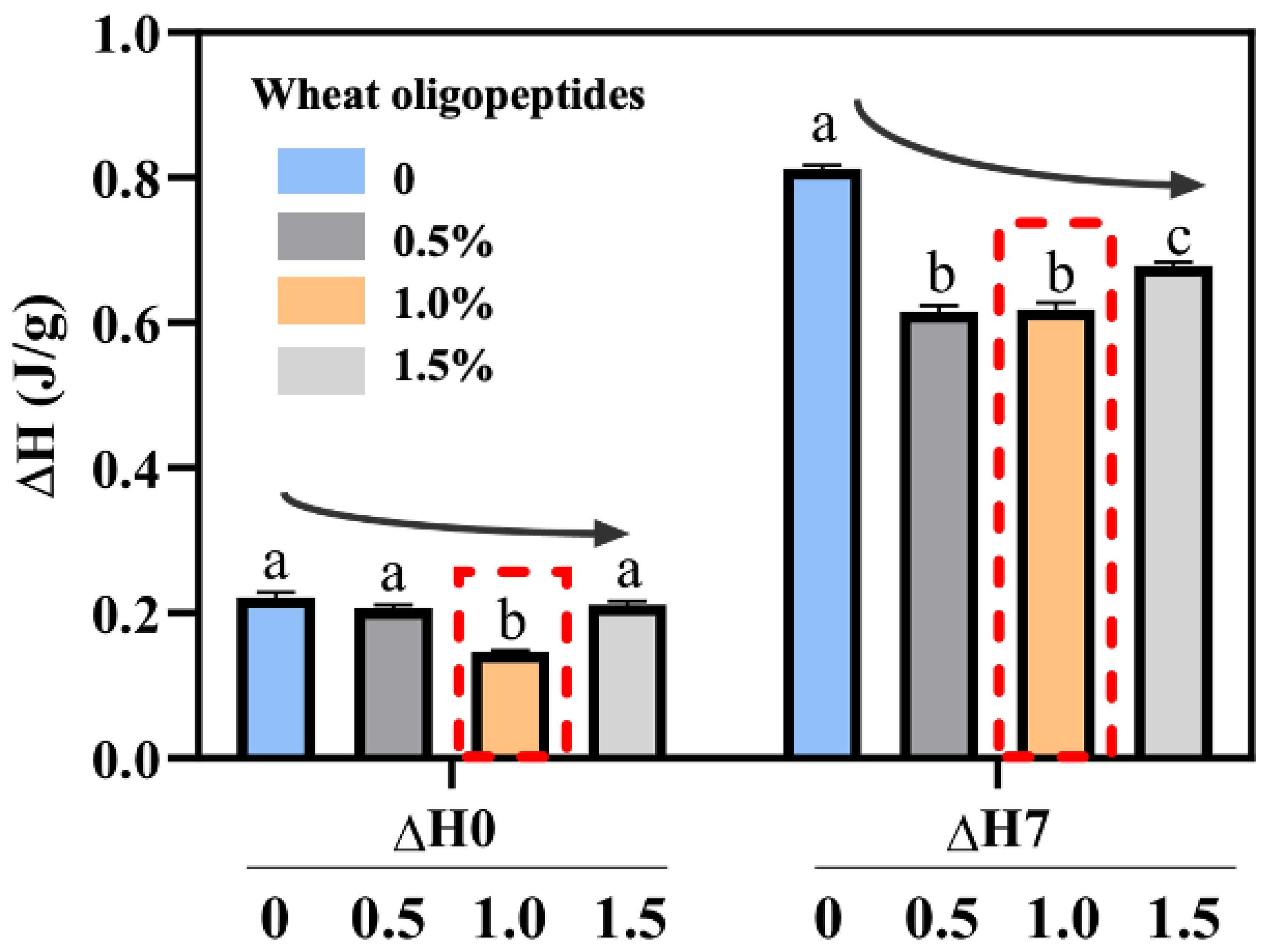

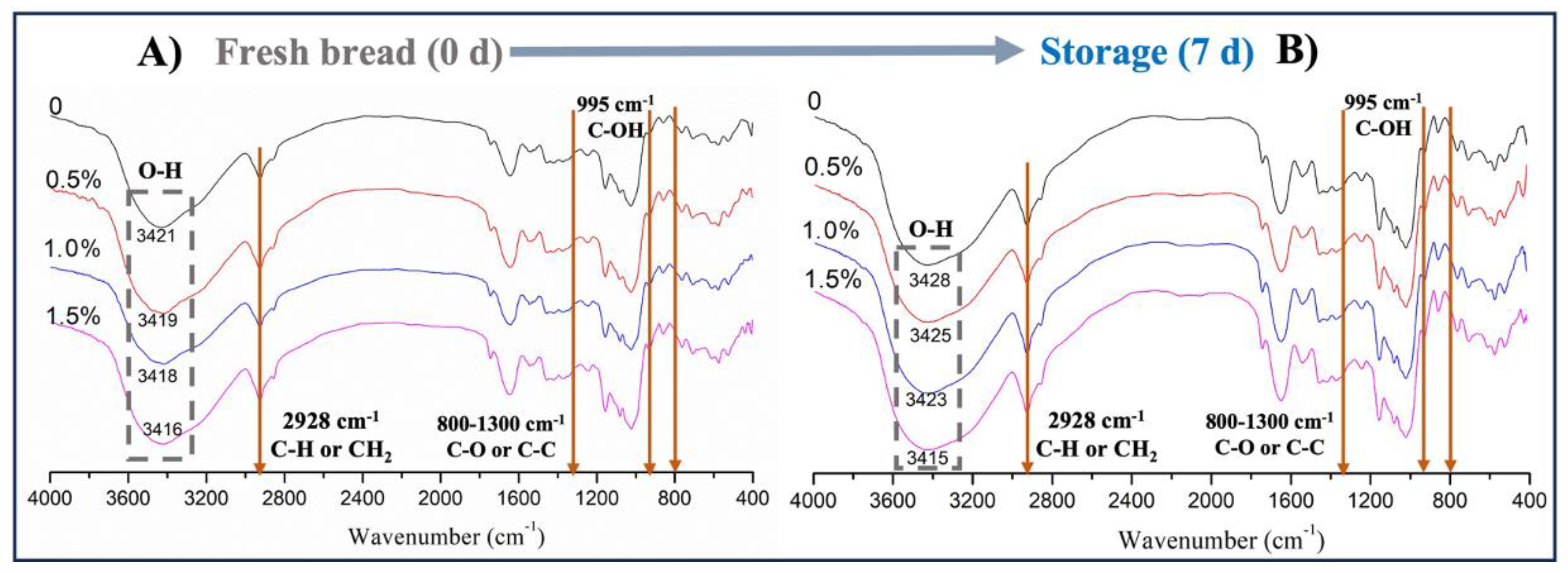
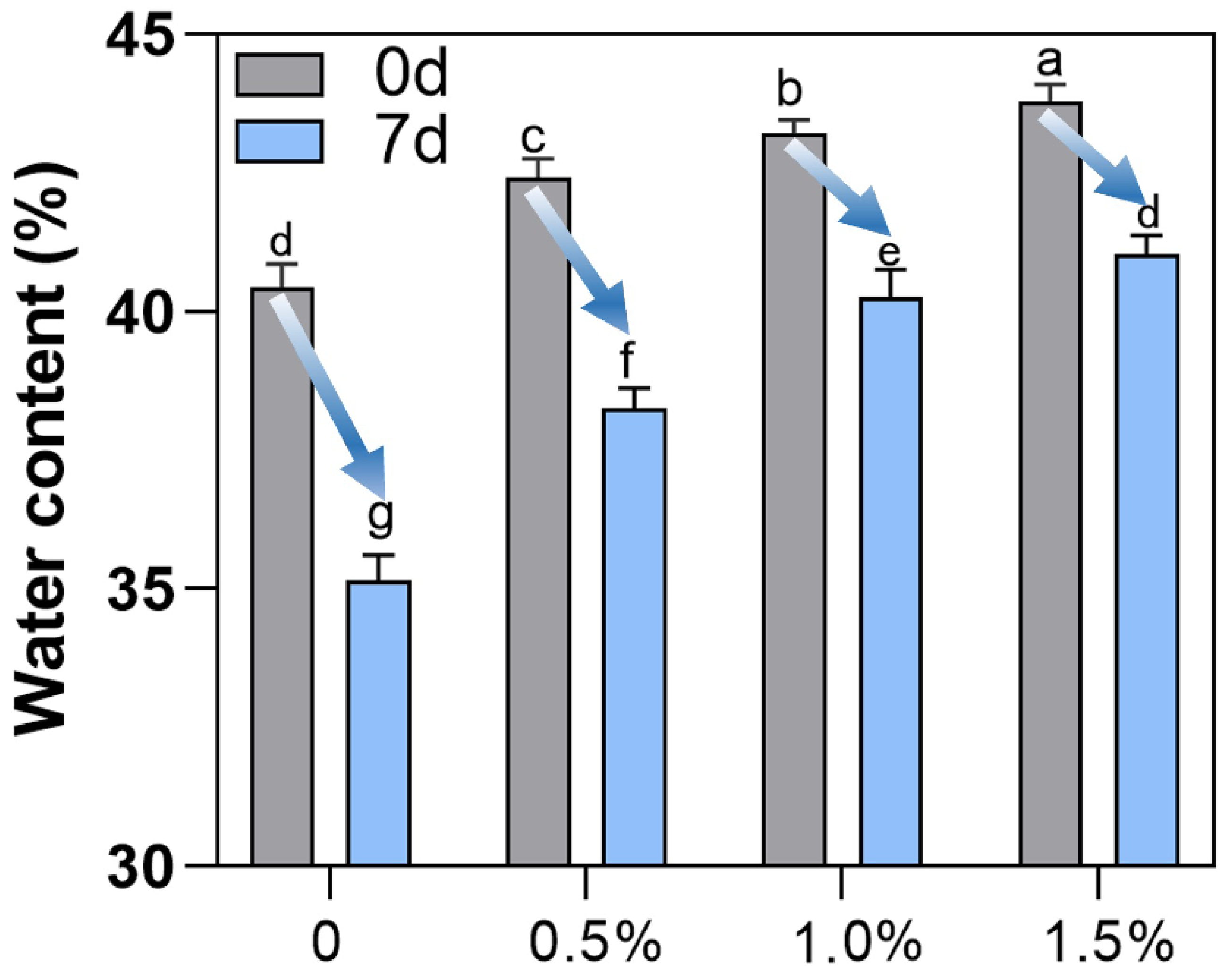

| WOP (%) | Storage (d) | 0 | 0.5 | 1.0 | 1.5 |
|---|---|---|---|---|---|
| R1047/1022 | 0 d | 0.891 ± 0.006 aA | 0.826 ± 0.008 aA | 0.726 ± 0.011 aB | 0.808 ± 0.005 aA |
| 7 d | 1.013 ± 0.008 bA | 0.956 ± 0.012 bB | 0.960 ± 0.008 bB | 0.971 ± 0.006 bB | |
| R995/1022 | 0 d | 1.114 ± 0.005 aA | 1.030 ± 0.007 aA | 0.933 ± 0.009 aB | 1.044 ± 0.012 aA |
| 7 d | 1.323 ± 0.011 bA | 1.196 ± 0.005 bB | 0.954 ± 0.013 aC | 1.171 ± 0.009 aB |
Disclaimer/Publisher’s Note: The statements, opinions and data contained in all publications are solely those of the individual author(s) and contributor(s) and not of MDPI and/or the editor(s). MDPI and/or the editor(s) disclaim responsibility for any injury to people or property resulting from any ideas, methods, instructions or products referred to in the content. |
© 2024 by the authors. Licensee MDPI, Basel, Switzerland. This article is an open access article distributed under the terms and conditions of the Creative Commons Attribution (CC BY) license (https://creativecommons.org/licenses/by/4.0/).
Share and Cite
Zhang, Y.; Liu, X.; Yu, J.; Fu, Y.; Liu, X.; Li, K.; Yan, D.; Barba, F.J.; Ferrer, E.; Wang, X.; et al. Effects of Wheat Oligopeptide on the Baking and Retrogradation Properties of Bread Rolls: Evaluation of Crumb Hardness, Moisture Content, and Starch Crystallization. Foods 2024, 13, 397. https://doi.org/10.3390/foods13030397
Zhang Y, Liu X, Yu J, Fu Y, Liu X, Li K, Yan D, Barba FJ, Ferrer E, Wang X, et al. Effects of Wheat Oligopeptide on the Baking and Retrogradation Properties of Bread Rolls: Evaluation of Crumb Hardness, Moisture Content, and Starch Crystallization. Foods. 2024; 13(3):397. https://doi.org/10.3390/foods13030397
Chicago/Turabian StyleZhang, Yuting, Xiaorong Liu, Junbo Yu, Yang Fu, Xiangjun Liu, Ku Li, Dongfang Yan, Francisco J. Barba, Emlia Ferrer, Xuedong Wang, and et al. 2024. "Effects of Wheat Oligopeptide on the Baking and Retrogradation Properties of Bread Rolls: Evaluation of Crumb Hardness, Moisture Content, and Starch Crystallization" Foods 13, no. 3: 397. https://doi.org/10.3390/foods13030397







